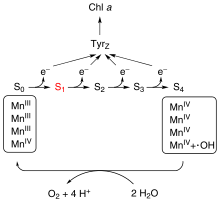Oxygen-evolving complex


The oxygen-evolving complex (OEC), also known as the water-splitting complex, is a water-oxidizing enzyme involved in the
oxidation.[3] Based on a widely accepted theory from 1970 by Kok, the complex can exist in 5 states, denoted S0 to S4, with S0 the most reduced and S4 the most oxidized. Photons trapped by photosystem II move the system from state S0 to S4. S4 is unstable and reacts with water producing free oxygen. For the complex to reset to the lowest state, S0, it uses 2 water molecules to pull out 4 electrons
.
The OEC active site contains a cluster of manganese and calcium, with the formula Mn4Ca1OxCl1–2(HCO3)y. This cluster is coordinated by D1 and CP43 subunits and stabilized by peripheral membrane proteins. Other characteristics of it have been reviewed.[4]
Currently, the mechanism of the complex is not completely understood, along with the role of Ca+2, Cl−1, and the membrane proteins surrounding the metal cluster.[5][6] Much of what is known has been collected from flash photolysis experiments, electron paramagnetic resonance (EPR), and X-ray spectroscopy.[7]
References
- S2CID 205224374.
- .
- ^ Johnson, James. "The Origin of Life - The Rise of the Oxygen Evolving Complex". www.chm.bris.ac.uk. Florida University. Retrieved 2020-04-30.
- ^ Abstract : Manganese: The Oxygen-Evolving Complex & Models1 : Encyclopedia of Inorganic Chemistry : Wiley InterScience
- PMID 28001034.
- ^
Yano, Junko; Kern, Jan; Yachandra, Vittal K.; Nilsson, Håkan; Koroidov, Sergey; Messinger, Johannes (2015). "Light-Dependent Production of Dioxygen in Photosynthesis". In Peter M.H. Kroneck and Martha E. Sosa Torres (ed.). Sustaining Life on Planet Earth: Metalloenzymes Mastering Dioxygen and Other Chewy Gases. Metal Ions in Life Sciences. Vol. 15. Springer. pp. 13–43. PMID 25707465.
- S2CID 31914925.
